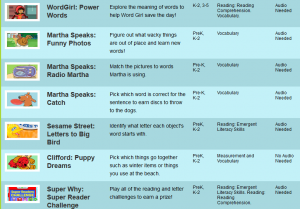Smart Board Games (Grades K-3)
 Smart Board Games - A collection of interactive smart board games for educators. Students will enjoy participating in these collaborative, fun and engaging experiences, while exploring curriculum from trusted programs such as Curious George, Super Why and Arthur. Like our programs, all of our games are age-appropriate and vetted by educators. Language Arts, Math and Social Studies.
Smart Board Games - A collection of interactive smart board games for educators. Students will enjoy participating in these collaborative, fun and engaging experiences, while exploring curriculum from trusted programs such as Curious George, Super Why and Arthur. Like our programs, all of our games are age-appropriate and vetted by educators. Language Arts, Math and Social Studies.
Conventions of Standard English:
CCSS.ELA-Literacy.L.K.1
Demonstrate command of the conventions of standard English grammar and usage when writing or speaking.
CCSS.ELA-Literacy.L.K.1.a
Print many upper- and lowercase letters.
CCSS.ELA-Literacy.L.K.1.b
Use frequently occurring nouns and verbs.
CCSS.ELA-Literacy.L.K.1.c
Form regular plural nouns orally by adding /s/ or /es/ (e.g., dog, dogs; wish, wishes).
CCSS.ELA-Literacy.L.K.1.d
Understand and use question words (interrogatives) (e.g., who, what, where, when, why, how).
CCSS.ELA-Literacy.L.K.1.e
Use the most frequently occurring prepositions (e.g., to, from, in, out, on, off, for, of, by, with).
CCSS.ELA-Literacy.L.K.1.f
Produce and expand complete sentences in shared language activities.
CCSS.ELA-Literacy.L.K.2
Demonstrate command of the conventions of standard English capitalization, punctuation, and spelling when writing.
CCSS.ELA-Literacy.L.K.2.a
Capitalize the first word in a sentence and the pronoun I
CCSS.ELA-Literacy.L.K.2.b
Recognize and name end punctuation.
CCSS.ELA-Literacy.L.K.2.c
Write a letter or letters for most consonant and short-vowel sounds (phonemes).
CCSS.ELA-Literacy.L.K.2.d
Spell simple words phonetically, drawing on knowledge of sound-letter relationships.
Conventions of Standard English:
CCSS.ELA-Literacy.L.1.1
Demonstrate command of the conventions of standard English grammar and usage when writing or speaking.
CCSS.ELA-Literacy.L.1.1.a
Print all upper- and lowercase letters.
CCSS.ELA-Literacy.L.1.1.b
Use common, proper, and possessive nouns.
CCSS.ELA-Literacy.L.1.1.c
Use singular and plural nouns with matching verbs in basic sentences (e.g., He hops; We hop).
CCSS.ELA-Literacy.L.1.1.d
Use personal, possessive, and indefinite pronouns (e.g., I, me, my; they, them, their, anyone, everything).
CCSS.ELA-Literacy.L.1.1.e
Use verbs to convey a sense of past, present, and future (e.g., Yesterday I walked home; Today I walk home; Tomorrow I will walk home).
CCSS.ELA-Literacy.L.1.1.f
Use frequently occurring adjectives.
CCSS.ELA-Literacy.L.1.1.g
Use frequently occurring conjunctions (e.g., and, but, or, so, because).
CCSS.ELA-Literacy.L.1.1.h
Use determiners (e.g., articles, demonstratives).
CCSS.ELA-Literacy.L.1.1.i
Use frequently occurring prepositions (e.g., during, beyond, toward).
CCSS.ELA-Literacy.L.1.1.j
Produce and expand complete simple and compound declarative, interrogative, imperative, and exclamatory sentences in response to prompts.
CCSS.ELA-Literacy.L.1.2
Demonstrate command of the conventions of standard English capitalization, punctuation, and spelling when writing.
CCSS.ELA-Literacy.L.1.2.a
Capitalize dates and names of people.
CCSS.ELA-Literacy.L.1.2.b
Use end punctuation for sentences.
CCSS.ELA-Literacy.L.1.2.c
Use commas in dates and to separate single words in a series.
CCSS.ELA-Literacy.L.1.2.d
Use conventional spelling for words with common spelling patterns and for frequently occurring irregular words.
CCSS.ELA-Literacy.L.1.2.e
Spell untaught words phonetically, drawing on phonemic awareness and spelling conventions.
CCSS.ELA-Literacy.L.2.2
Demonstrate command of the conventions of standard English capitalization, punctuation, and spelling when writing.
CCSS.ELA-Literacy.L.2.2.a
Capitalize holidays, product names, and geographic names.
Math
Know number names and the count sequence.
CCSS.Math.Content.K.CC.A.1
Count to 100 by ones and by tens.
CCSS.Math.Content.K.CC.A.2
Count forward beginning from a given number within the known sequence (instead of having to begin at 1).
CCSS.Math.Content.K.CC.A.3
Write numbers from 0 to 20. Represent a number of objects with a written numeral 0-20 (with 0 representing a count of no objects).
Count to tell the number of objects.
CCSS.Math.Content.K.CC.B.4
Understand the relationship between numbers and quantities; connect counting to cardinality.
CCSS.Math.Content.K.CC.B.4.a
When counting objects, say the number names in the standard order, pairing each object with one and only one number name and each number name with one and only one object.
CCSS.Math.Content.K.CC.B.4.b
Understand that the last number name said tells the number of objects counted. The number of objects is the same regardless of their arrangement or the order in which they were counted.
CCSS.Math.Content.K.CC.B.4.c
Understand that each successive number name refers to a quantity that is one larger.
CCSS.Math.Content.K.CC.B.5
Count to answer "how many?" questions about as many as 20 things arranged in a line, a rectangular array, or a circle, or as many as 10 things in a scattered configuration; given a number from 1-20, count out that many objects.
Add and subtract within 20.
CCSS.Math.Content.1.OA.C.5
Relate counting to addition and subtraction (e.g., by counting on 2 to add 2).
CCSS.Math.Content.1.OA.C.6
Add and subtract within 20, demonstrating fluency for addition and subtraction within 10. Use strategies such as counting on; making ten (e.g., 8 + 6 = 8 + 2 + 4 = 10 + 4 = 14); decomposing a number leading to a ten (e.g., 13 - 4 = 13 - 3 - 1 = 10 - 1 = 9); using the relationship between addition and subtraction (e.g., knowing that 8 + 4 = 12, one knows 12 - 8 = 4); and creating equivalent but easier or known sums (e.g., adding 6 + 7 by creating the known equivalent 6 + 6 + 1 = 12 + 1 = 13).
Measure lengths indirectly and by iterating length units.
CCSS.Math.Content.1.MD.A.1
Order three objects by length; compare the lengths of two objects indirectly by using a third object.
CCSS.Math.Content.1.MD.A.2
Express the length of an object as a whole number of length units, by laying multiple copies of a shorter object (the length unit) end to end; understand that the length measurement of an object is the number of same-size length units that span it with no gaps or overlaps. Limit to contexts where the object being measured is spanned by a whole number of length units with no gaps or overlaps.